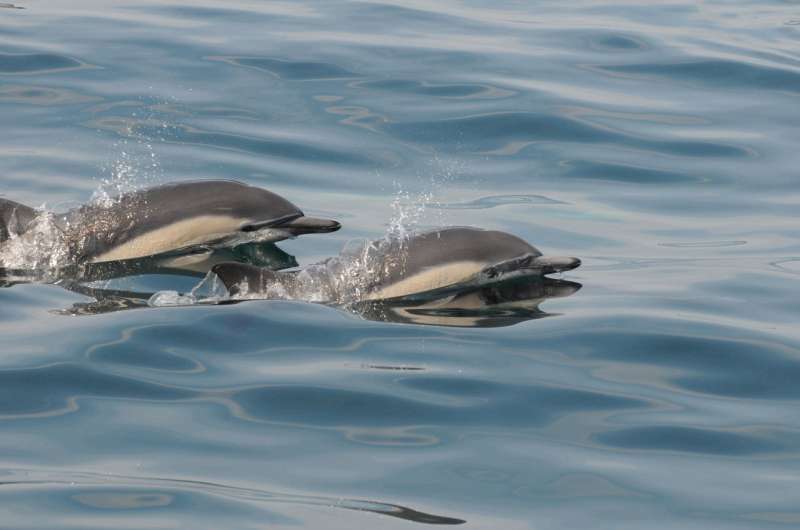Climate shifts shorten marine food chain off California

Environmental disturbances such as El Niño shake up the marine food web off Southern California, new research shows, countering conventional thinking that the hierarchy of who-eats-who in the ocean remains largely constant over time.
The new research published in the journal Science Advances examined the skin cells of common dolphins for chemical clues about the length of the marine food chain, which begins with tiny plankton and continues as species eat them, and other species eat those species. Large predators such as dolphins occupy the top of the food chain, their cells carrying chemical information from all the species beneath them.
Many scientists have long considered the length of the food chain in the open sea to be relatively stable, with roughly the same animal species feeding on each other through time. But the chemical signatures in the skin of Southern California dolphins collected over two decades now show otherwise, report scientists from NOAA Fisheries, Moss Landing Marine Laboratories and the Scripps Institution of Oceanography.
"We documented for first time marked changes in the pelagic food web length in response to various natural and anthropogenic related stressors," said lead author Rocio I. Ruiz-Cooley, formerly of NOAA Fisheries' Southwest Fisheries Science Center and now at Moss Landing Marine Laboratories. "This tells us that the food web is very dynamic, and reveals changes with the ecosystem around it."
The finding helps scientists understand the health and resilience of the ecosystem, she said. A longer food chain is more typical, and reflects a relatively diverse community, while shorter chains occur during extreme environmental conditions and suggest a decline in that diversity.
During strong climate perturbations such as the 1997-1999 El Niño Southern Oscillation that included the most intense El Niño event of the century, which brought unusual warming to the U.S. West Coast, the food chain in the California Current shortened sharply, the scientists found. That coincided with declines in ocean productivity such as reduced growth of plankton, declines of some fish and birds and expanded ranges of some species such as jumbo squid, perhaps as they searched for scarce food or followed favorable temperatures.
"These changes in life history traits and population dynamics likely reduced and/or removed populations of many species, including important components of the food web," in turn shrinking the food chain, scientists wrote in the new report. Predators may have exacerbated this impact as they fed on what was left and reduced the length of the food chain that supported them. Although some species such as jellyfish and tunicates such as salp may multiply quickly to fill such gaps, they provide so little nutrition that most predators do not pursue them and the food chain remains short.
The research demonstrates that top predators such as the common dolphin can serve as important indicators of the length of the food chain, which in turn provides insight into the ecosystem, Ruiz-Cooley said. The study drew upon the Southwest Fisheries Science Center's collection of skin tissue samples gathered from dolphins inadvertently entangled in gillnets off Southern California from 1991 to 2008, highlighting the value of that collection over time.
"This research, and the results it has produced, illustrate the great value of this time series reflected in the cell samples," said Lisa Ballance, director of the Science Center's Marine Mammal and Turtle Division, and coauthor on this paper. "As technology advances, we can extract even more information from the time series as a window into the past, and a baseline to address tomorrow's emerging issues."
More information: Rocio I. Ruiz-Cooley et al, Temporal variation in pelagic food chain length in response to environmental change, Science Advances (2017). DOI: 10.1126/sciadv.1701140
Journal information: Science Advances
Provided by NOAA Headquarters


















